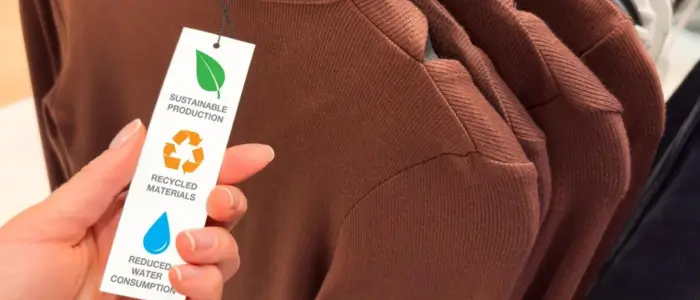
No matter how much we want to look the best among everyone by wearing stylish clothes. Eventually, there comes a time in life, when the clothing you bought doesn’t fit your body or you get bored wearing it again and again over the years. And then the garments are thrown away into landfills or shreds, which invites environmental catastrophes. Have you ever considered how simple steps of recycling your clothes can have a huge impact on society and the atmosphere?
In this blog we will tell you about some responsible practices of dumping your clothing by which we can save the environment, understand the purpose of the 4R’s in sustainable fashion, and highlight some benefits that are provided to both society and the environment.
The 4R’s Principle in Eco-Friendly Fashion

Before we dive deeper, first let’s familiarize ourselves with the 4R’s in an eco-friendly fashion.
Reduce: This principle encourages consumers to minimize their clothing consumption, therefore by purchasing quality over quantity. This simple step can help lower the demand for fast fashion, which often leads to excessive waste.
Reuse: By the principle of reusing, you can extend the lifespan of your apparel and find a new purpose for it. Thrifting is another fantastic way to give your worn clothes a second chance.
Recycle: Recycling keeps clothing out of landfills and reduces the need for raw materials. They can be repurposed into new items, such as cleaning cloths or pillows.
Recover: Get creative and find new uses for your old clothes. Turn a worn-out t-shirt into cleaning rags or transform an old pair of jeans into stylish shorts. Repurposing allows you to bring new life into your wardrobe staples.
Significance Of Recycling Clothes
Today, many of us are guilty of hoarding clothes that we no longer wear, thinking we might need them someday, but eventually dispose of them after they don’t fit the body. According to the latest research, do you know that an average US consumer dumps 81.5 lbs. of clothing every year. That means almost 10,000 clothing items are sent to landfills or dumped every five minutes.
However, the recycling of clothes is a sustainable and responsible approach to managing your closet without causing damage to the environment. Not only does this practice reduce textile waste, but it also has an impact on the mindset of a consumer.
Impact of Recycled Clothing on Consumer Mindsets

Recycled clothing has significantly influenced the mindsets of consumers over the years. As environmental concerns have risen in a short span of time, people have become more self-aware about sustainable fashion. Recycling used or old clothes has encouraged consumers to think twice before purchasing a new style of apparel that suits their personality.
A sense of responsibility is promoted among consumers, which motivates them to make eco-friendly choices and choose apparel that reduces their carbon footprints. This shift in consumer behavior is advantageous to the environment and highlights the understanding that every tiny action matters in the global effort to slow down climate change and protect the world for future generations.
Impact of Recycled Clothing on Environment
Many clothing brands have been working on the repurposing of used clothes and have been successful in making an impact on both the environment and consumer behaviors. When it comes to the environment, there is no doubt that sustainable fashion has made a huge difference.
By repurposing clothes, the consumption of textile wastes in landfills results in the reduction of greenhouse gas emissions. Additionally, it reduces the necessity for incineration, which adds dangerous pollutants to the atmosphere. Choosing to use recycled clothing is crucial for reducing the environmental impact of disposed garments, promoting sustainability, and protecting the ecosystem for future generations.
Advantages of Eco-Friendly Fashion

As the winter season is right at the corner, people will be purchasing outerwear to stay warm and stylish. But do you know that these cozy jackets are worn out after a time and then dumped? One way to make a positive change is by recycling your clothes this snowy season. They can be really beneficial both environmentally and socially for many reasons. Let’s discuss some of them:
Societal Benefits:
Job Possibilities: The recycling industry creates employment opportunities, from collection and sorting to repurposing and selling second-hand clothing.
Affordable Clothing: Thrift stores and second-hand markets offer budget-friendly wholesale clothing options, making fashion accessible to a wider range of people.
Donation Opportunities: Donating your used clothing to charitable organizations can directly benefit those in need.
Environmental Benefits:
Reduced Pollution: Recycling clothes reduces the need for new textile production, which is often associated with heavy pollution from dyeing and finishing processes.
Reduction in Energy and Water Conservation: Recycling requires less energy and water compared to purchasing new clothes, lowering the industry’s overall resource consumption.
Landfill Diversion: By recycling, we divert textiles from landfills, helping to fight the problem of overflowing waste dumps.
The Role of Sustainability in Recycling of Clothes

Sustainability is at the forefront of revolutionizing the recycling of clothes. It starts with the fundamental principle of reducing waste and minimizing the environmental impact. Sustainable practices such as resale, repurposing, or donation can extend the life of old clothes, which reduces the need for new clothes. Brands that prioritize sustainability are more likely to create clothing that is durable, repairable, and designed with recycling in mind.
Moreover, sustainable recycling procedures provide a way for people to contribute to lowering the overall carbon footprint and its negative social repercussions as customers become more conscious of the environmental and social effects of their clothing choices.
Reverse Logistics Making Recycling of Clothes Easier
Have you ever wondered what happens to your old clothes after you donate them? Reverse logistics is the answer! It’s the behind-the-scenes magic that makes recycling apparel so simple.
Reverse Logistics refers to the process of moving goods from their final destination back to the manufacturer or designated recycling facility. This process is crucial for the recycling of clothes because it involves the collecting and transportation of used or old clothes from consumers back to the retailers. Nowadays, a number of manufacturers have take-back programs, making it simpler for customers to ethically recycle their old clothing. By participating in such initiatives, consumers actively contribute to reducing textile waste and encouraging brands to adopt more sustainable practices.
Green House Practices in Recycling of Clothes

The people dispose of their worn-out clothes after a time which has some harmful effects on the environment are being significantly reduced thanks to green practices in clothing recycling. The collection and sorting of used clothes to keep them out of landfills is one of the core components of this technique. Recycling clothes has also encouraged fashion industry innovation and pushed the creation of eco-friendly products and technology. Recycled materials are being used by brands and designers in their collections more often, proving that fashion can be both fashionable and ethical.
Green practices frequently stress the value of using eco-friendly colors and sustainable materials in the creation of new clothing products, which helps the fashion industry as a whole reduce its carbon footprint.
Conclusion
Lastly, applying these sustainable clothing practices, along with utilizing screen printing and embroidery services, can help you transform your closet and minimize the consequences of environmental dangers. By recycling your clothes thoughtfully and personalizing them with these services, you can contribute to a more eco-friendly fashion industry. Remember that small changes in your wardrobe habits can lead to a big difference in the world’s sustainability efforts.
Published on:
May 1, 2024




